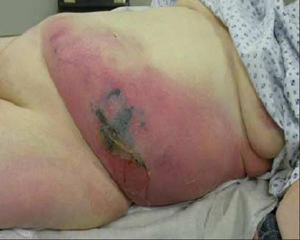Resumen
Definición
Anamnesis y examen
Principales factores de diagnóstico
- history of traumatic or nontraumatic cutaneous lesion
- anesthesia or severe pain over site of cellulitis
- fever
- palpitations, tachycardia, tachypnea, hypotension, and lightheadedness
- nausea and vomiting
- delirium
- crepitus
- vesicles or bullae
- gray discoloration of skin
- edema or induration
- location of lesion
Factores de riesgo
- inpatient contact with index case
- Varicella zoster infection
- cutaneous injury, surgery, trauma
- nontraumatic skin lesions
- intravenous drug use
- chronic illness
- immunosuppression
- use of nonsteroidal anti-inflammatory drugs (NSAIDs)
Pruebas diagnósticas
Primeras pruebas diagnósticas para solicitar
- surgical exploration
- blood and tissue cultures
- gram stain
- complete blood count and differential
- serum electrolytes
- serum BUN and creatinine
- serum CRP
- serum creatine kinase (CK)
- serum lactate
- clotting screen
- arterial blood gas
Pruebas diagnósticas que deben considerarse
- radiography, CT/MRI, ultrasound
- fresh frozen section
Algoritmo de tratamiento
suspected necrotizing fasciitis, organism unknown
type I necrotizing fasciitis (polymicrobial)
type II necrotizing fasciitis due to group A streptococcus
type II necrotizing fasciitis due to Staphylococcus aureus
type II necrotizing fasciitis due to Vibrio vulnificus
type II necrotizing fasciitis due to Aeromonas hydrophila
type II necrotizing fasciitis due to mucorales
persistent cosmetic and functional defects after debridement
Colaboradores
Consejeros especializados
Ramia Zakhour, MD
Assistant Professor
Department of Pediatrics
University of Texas
McGovern Medical School
Houston
TX
Divulgaciones
RZ declares that they have no competing interests.
Agradecimientos
Dr Ramia Zakour would like to gratefully acknowledge Dr Kevin Steiner and Dr William Petri, previous contributors to this topic.
Divulgaciones
KS and WP declared they have no competing interests.
Revisores por pares
Felix Lui, MD, FACS
Associate Professor of Surgery
Yale School of Medicine
New Haven
VT
Divulgaciones
FL declares that he has no competing interests.
Shiranee Sriskandan, MA, MBBChir, FRCP, PhD
Professor of Infectious Diseases and Hon. Consultant
Section of Infectious Diseases
Imperial College London
London
UK
Divulgaciones
SS declares that she has no competing interests.
Agradecimiento de los revisores por pares
Los temas de BMJ Best Practice se actualizan de forma continua de acuerdo con los desarrollos en la evidencia y en las guías. Los revisores por pares listados aquí han revisado el contenido al menos una vez durante la historia del tema.
Divulgaciones
Las afiliaciones y divulgaciones de los revisores por pares se refieren al momento de la revisión.
Referencias
Artículos principales
Sartelli M, Guirao X, Hardcastle TC, et al. 2018 WSES/SIS-E consensus conference: recommendations for the management of skin and soft-tissue infections. World J Emerg Surg. 2018 Dec 14;13:58.Texto completo Resumen
Stevens DL, Bisno AL, Chambers HF, et al. Practice guidelines for the diagnosis and management of skin and soft tissue infections: 2014 update by the Infectious Diseases Society of America. Clin Infect Dis. 2014 Jul 15;59(2):e10-52.Texto completo Resumen
Artículos de referencia
Una lista completa de las fuentes a las que se hace referencia en este tema está disponible para los usuarios con acceso a todo BMJ Best Practice.

Diferenciales
- Cellulitis
- Impetigo
- Erysipelas
Más DiferencialesGuías de práctica clínica
- WSES/GAIS/WSIS/SIS-E/AAST global clinical pathways for patients with skin and soft tissue infections
- 2018 WSES/SIS-E consensus conference: recommendations for the management of skin and soft-tissue infections
Más Guías de práctica clínicaInicie sesión o suscríbase para acceder a todo el BMJ Best Practice
El uso de este contenido está sujeto a nuestra cláusula de exención de responsabilidad